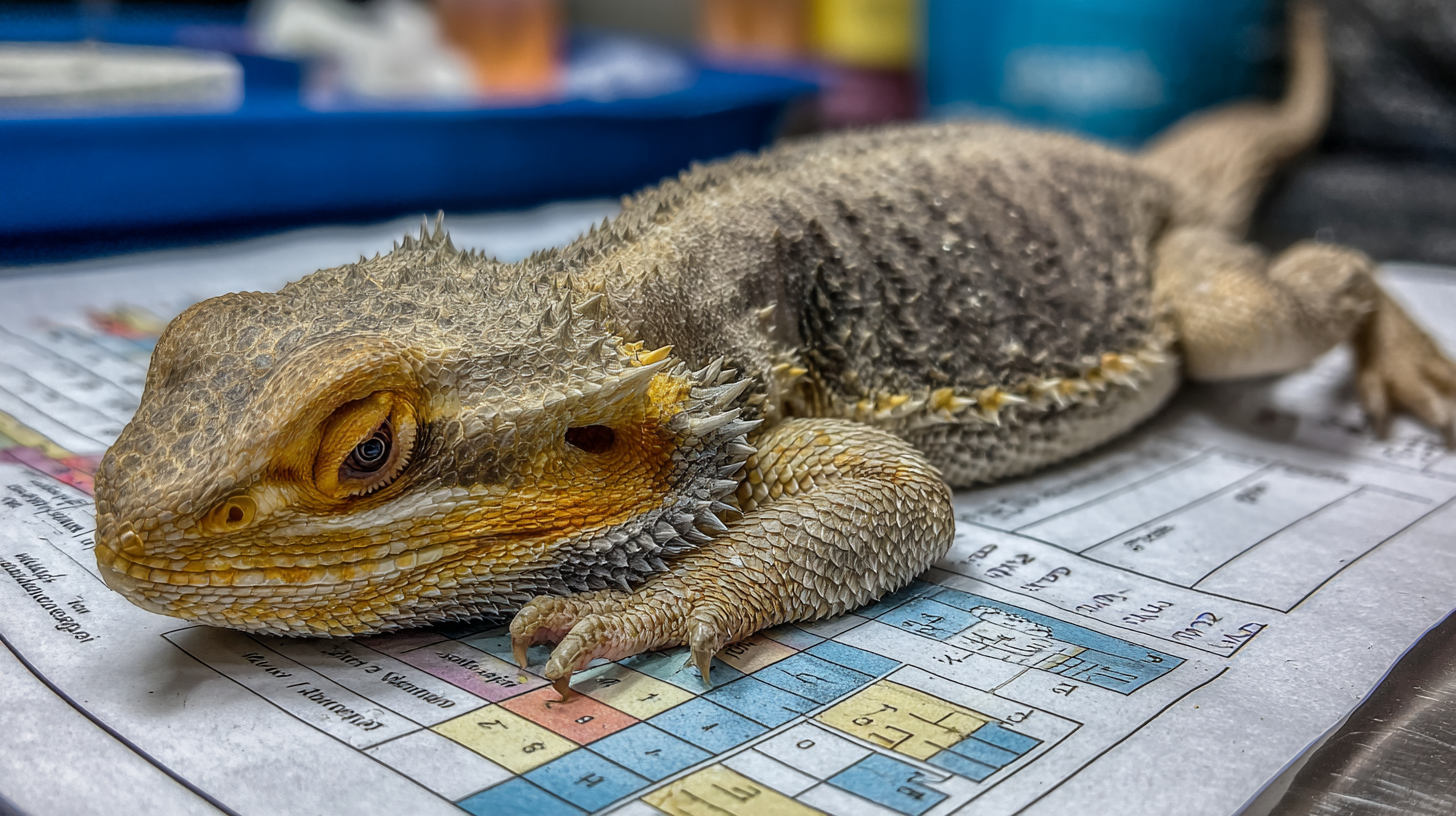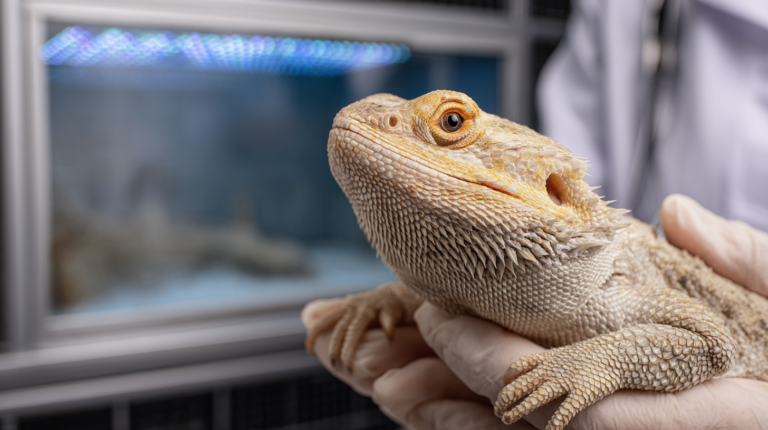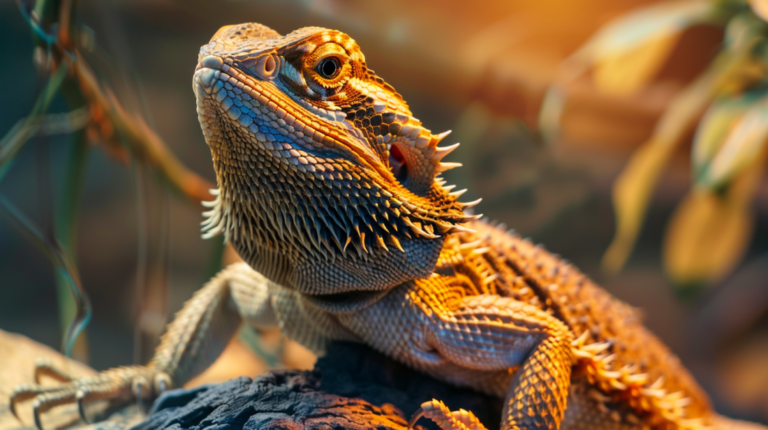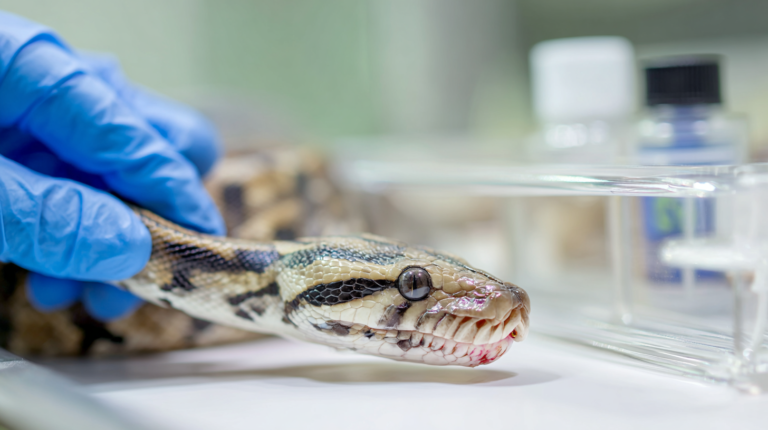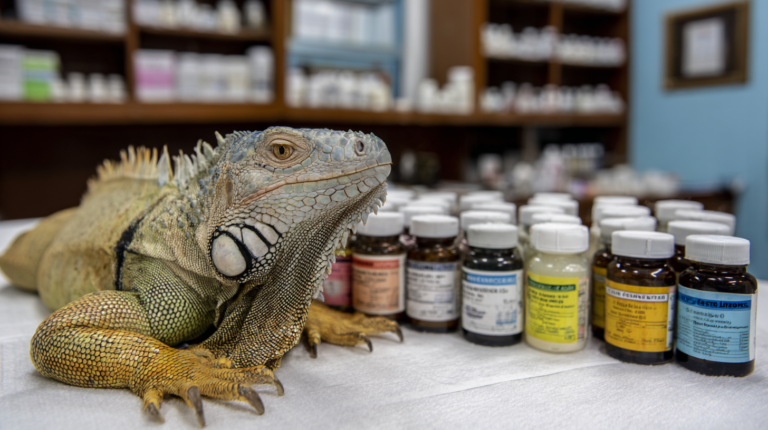Discover the 5 critical signs of poisoning in reptiles every owner must know. Learn emergency care, prevention tips, and when to seek veterinary help immediately.
Table of Contents
Every year, thousands of reptile owners face the devastating reality of accidental poisoning in their beloved pets. Unlike dogs or cats, reptiles exhibit subtle warning signs that can easily be overlooked until it’s too late. Understanding poisoning in reptiles could mean the difference between life and death for your scaly companion.
Dr. Sarah Martinez, a board-certified exotic animal veterinarian with over 15 years of experience, emphasizes the urgency: “Reptile poisoning cases have increased by 23% in the past five years, primarily due to household toxins and improper habitat management. The key to survival lies in early recognition and immediate intervention.”
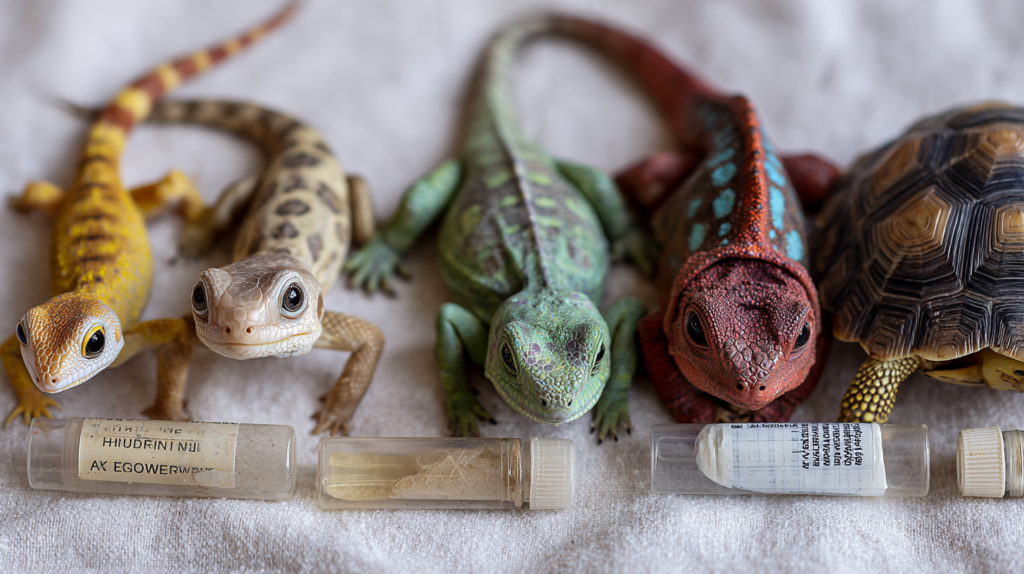
This comprehensive guide will equip you with the knowledge to identify the five most alarming signs of reptile poisoning, understand common toxic substances, and take life-saving action when every second counts. Whether you’re a seasoned herpetologist or a first-time reptile owner, this information could save your pet’s life.
Understanding Reptile Poisoning: The Silent Threat
| Warning Sign | Symptom Category | Key Indicators | Urgency Level |
|---|---|---|---|
| 1. Neurological Abnormalities | Behavioral Changes |
Disorientation, seizures, tremors, unusual movements, loss of coordination | Critical |
| 2. Respiratory Distress | Breathing Issues |
Labored breathing, mouth breathing, wheezing, gasping, irregular patterns | Critical |
| 3. Gastrointestinal Disturbances | Digestive Problems |
Vomiting, diarrhea, appetite loss, unusual drooling, abdominal swelling | High |
| 4. Dermatological Changes | Skin & Scale Issues |
Color changes, lesions, unusual shedding, skin irritation, scale damage | High |
| 5. Cardiovascular Symptoms | Circulatory Problems |
Weak pulse, color changes in mucous membranes, lethargy, circulation issues | Critical |
Poisoning in reptiles occurs when these sensitive creatures ingest, inhale, or absorb toxic substances through their skin. Unlike mammals, reptiles have unique physiological characteristics that make them particularly vulnerable to certain toxins while resistant to others. Their slow metabolism means toxins can accumulate over time, making chronic poisoning as dangerous as acute exposure.
Recent studies from the Association of Reptilian and Amphibian Veterinarians (ARAV) reveal that 67% of reptile poisoning cases stem from environmental toxins, 28% from dietary sources, and 5% from medication overdoses. Understanding these statistics helps us appreciate the multifaceted nature of reptile toxicity.
Reptiles process toxins differently than warm-blooded animals. Their liver detoxification pathways are less developed, and their kidneys filter waste more slowly. This biological reality means that substances harmless to humans or other pets can prove fatal to reptiles. Additionally, their permeable skin allows certain chemicals to be absorbed directly into their bloodstream, bypassing the digestive system entirely.
The complexity of reptile poisoning extends beyond simple ingestion. Factors such as species, size, age, temperature, and overall health status all influence how a reptile responds to toxic exposure. A substance that might cause mild discomfort in a large monitor lizard could prove lethal to a small gecko.
The 5 Alarming Signs of Poisoning in Reptiles
1. Neurological Abnormalities: When Behavior Goes Wrong
The most immediate and concerning sign of reptile poisoning manifests in the nervous system. Reptiles experiencing neurological toxicity display a range of alarming behaviors that deviate dramatically from their normal patterns.
Tremors and Seizures: Visible shaking, convulsions, or rhythmic muscle contractions indicate severe neurological compromise. These symptoms often begin subtly—a slight tremor in the tail or limbs—before progressing to full-body seizures. Organophosphate poisoning, commonly from insecticides, frequently causes these dramatic neurological symptoms.
Loss of Coordination: A previously agile reptile suddenly appears clumsy, stumbling, or unable to maintain proper posture. This ataxia often presents as difficulty climbing, irregular gait patterns, or inability to right themselves when turned upside down. Venomous snake bites in reptiles can cause similar coordination problems.
Altered Mental Status: Reptiles may appear disoriented, fail to respond to stimuli, or display unusual aggression or lethargy. A normally alert bearded dragon might become completely unresponsive to food or handling, while a typically docile snake might strike unpredictably.
Abnormal Eye Movements: Rapid, involuntary eye movements (nystagmus) or fixed, dilated pupils often accompany neurological poisoning. These symptoms indicate severe brain involvement and require immediate veterinary attention.
Case study: A ball python owner noticed subtle head tremors in their pet after using a new substrate. Within hours, the tremors progressed to full-body seizures. Laboratory analysis revealed the substrate contained phenol-based chemicals that caused acute neurological toxicity.
2. Respiratory Distress: Fighting for Every Breath
Respiratory symptoms in poisoned reptiles can be particularly subtle initially, making early detection challenging. Unlike mammals, reptiles don’t pant or wheeze in obvious ways, requiring careful observation to identify breathing difficulties.
Mouth Breathing: Reptiles typically breathe through their nostrils with their mouths closed. Open-mouth breathing, especially at rest, indicates respiratory distress. This symptom often accompanies exposure to volatile organic compounds or respiratory irritants.
Irregular Breathing Patterns: Normal reptile breathing involves slow, regular chest movements. Poisoned reptiles may exhibit rapid, shallow breathing or prolonged pauses between breaths. Some toxins cause respiratory depression, leading to dangerously slow breathing rates.
Gasping Motions: Visible struggling for air, with exaggerated neck extensions and mouth opening, indicates severe respiratory compromise. This symptom often occurs with household cleaners, perfumes, or aerosol exposure.
Foam or Discharge: Excess mucus, foam, or colored discharge from the mouth or nostrils suggests respiratory irritation or chemical burns. Caustic substances like bleach or ammonia-based cleaners commonly cause these symptoms.
Temperature plays a crucial role in reptile respiratory function. Poisoned reptiles may be unable to thermoregulate properly, compounding their respiratory distress. Maintaining appropriate temperatures becomes critical during treatment.
3. Gastrointestinal Disturbances: Internal Turmoil
The digestive system often bears the brunt of reptile poisoning, especially when toxins are ingested. Gastrointestinal symptoms can range from mild discomfort to life-threatening complications.
Vomiting and Regurgitation: While less common than in mammals, reptiles can and do vomit when poisoned. Regurgitation of recently consumed food, especially if it appears partially digested or contains blood, indicates serious gastrointestinal irritation.
Diarrhea or Abnormal Stools: Changes in stool consistency, color, or frequency signal digestive system distress. Bloody diarrhea, particularly dark or tarry stools, suggests internal bleeding and requires emergency treatment.
Loss of Appetite: A sudden refusal to eat in a previously healthy reptile often indicates poisoning. This symptom can be challenging to assess in species with naturally erratic feeding patterns, making knowledge of your pet’s normal habits crucial.
Excessive Drooling: Unusual amounts of saliva or foam around the mouth suggest oral irritation or nausea. This symptom often accompanies exposure to caustic substances or certain plant toxins.
Abdominal Distension: Visible swelling of the abdomen can indicate internal organ damage or fluid accumulation. This serious symptom requires immediate veterinary evaluation.
Dr. James Chen, exotic animal specialist at the University of California, notes: “Gastrointestinal symptoms in reptiles often present 12-24 hours after exposure, making it crucial to consider recent environmental changes or dietary additions when evaluating a sick reptile.”
4. Dermatological Changes: Skin Tells the Story
The skin serves as both a protective barrier and a window into a reptile’s internal health. Many toxic substances cause visible skin changes that alert owners to potential poisoning.
Color Changes: Abnormal darkening, lightening, or unusual color patterns often indicate circulatory or metabolic problems associated with poisoning. Cyanosis (blue or purple discoloration) suggests oxygen deprivation, while pallor might indicate blood loss or shock.
Swelling and Inflammation: Localized swelling, redness, or inflammation can result from direct contact with toxic substances. These symptoms often appear first at the site of contact before spreading to other areas.
Blistering or Ulceration: Chemical burns from acids, bases, or other caustic substances create painful blisters or open wounds. These lesions provide entry points for secondary infections and require immediate medical attention.
Excessive Shedding: Stress from poisoning can trigger premature or abnormal shedding patterns. This symptom often accompanies other signs of systemic illness.
Skin Texture Changes: Unusual roughness, scaliness, or other texture changes may indicate metabolic disruption from toxin exposure. These subtle changes often precede more obvious symptoms.
5. Cardiovascular and Circulatory Symptoms: Life-Threatening Changes
The cardiovascular system maintains life in reptiles, and poisoning can rapidly compromise this vital function. These symptoms often indicate advanced toxicity requiring immediate intervention.
Altered Heart Rate: While difficult to assess without specialized equipment, some reptiles may exhibit visible heart rate changes. Rapid or irregular heartbeats can sometimes be observed through the chest wall in smaller species.
Weak Pulse: A barely detectable pulse, assessed by gently palpating the ventral abdomen, indicates cardiovascular compromise. This symptom often accompanies severe dehydration or shock.
Poor Circulation: Cool body temperature, delayed capillary refill (if assessable), or unusual skin color all suggest circulatory problems. These symptoms indicate that the reptile’s body cannot maintain proper blood flow.
Collapse or Weakness: Severe weakness, inability to move, or complete collapse represents end-stage cardiovascular failure. These symptoms require immediate emergency care.
Irregular Breathing with Circulation: When respiratory symptoms combine with circulatory problems, the situation becomes critical. This combination often indicates multiple organ system failure.
Research from the International Association of Avian and Exotic Animal Veterinarians shows that cardiovascular symptoms in reptile poisoning cases carry a 78% mortality rate when treatment is delayed beyond 6 hours.
| Toxin Category | Common Sources | Primary Effects | Danger Level |
|---|---|---|---|
| Household Chemicals |
|
Respiratory distress, skin irritation, neurological symptoms | Extreme |
| Substrate Materials |
|
Respiratory issues, skin reactions, digestive problems | High |
| Plants & Foods |
|
Gastrointestinal distress, neurological issues, organ damage | High |
| Water Contaminants |
|
Digestive issues, skin problems, organ dysfunction | Moderate |
| Environmental Toxins |
|
Respiratory distress, neurological symptoms, skin irritation | High |
| Prey-Related Toxins |
|
Secondary poisoning, organ failure, digestive complications | Extreme |
Common Toxic Substances for Reptiles
Understanding what substances pose the greatest threat to reptiles helps prevent accidental poisoning. The following categories represent the most frequent causes of reptile toxicity:
Household Chemicals
Cleaning Products: Bleach, ammonia, phenol-based disinfectants, and carpet cleaners top the list of household hazards. These substances can cause chemical burns, respiratory irritation, and systemic toxicity. Even diluted solutions can prove dangerous to reptiles’ sensitive systems.
Pesticides and Insecticides: Organophosphates, carbamates, and pyrethrin-based products commonly cause neurological symptoms. These chemicals are particularly dangerous because they’re designed to target nervous systems, making them especially toxic to reptiles.
Air Fresheners and Perfumes: Volatile organic compounds in these products can cause respiratory distress and skin irritation. Automatic air fresheners pose particular risks in enclosed terrarium environments.
Adhesives and Solvents: Glues, paints, and solvents release toxic vapors that can cause respiratory and neurological symptoms. These substances often affect reptiles through inhalation rather than direct contact.
Substrate and Environment
Cedar and Pine Shavings: These popular substrate materials contain aromatic oils that can cause respiratory irritation and liver damage in reptiles. The oils can also interfere with normal bacterial flora in the digestive system.
Treated Wood: Pressure-treated lumber contains preservatives that leach into the environment over time. These chemicals can cause chronic poisoning through skin absorption and inhalation.
Fertilizers and Soil Amendments: Garden soils and fertilizers often contain nitrogen compounds, phosphates, and other chemicals that can cause gastrointestinal upset and metabolic disruption in reptiles.
Plants and Natural Toxins
Toxic Plants: Azaleas, oleander, foxglove, and many common houseplants contain cardiac glycosides, alkaloids, or other compounds toxic to reptiles. Even small amounts can cause serious poisoning.
Prey Items: Fireflies, wild-caught insects, and certain feeder fish can contain toxins that accumulate in reptiles. Lightning bugs are particularly dangerous due to their luciferin content.
Mushrooms and Fungi: Wild mushrooms and molds can produce mycotoxins that cause liver damage and neurological symptoms in reptiles.
Medications and Supplements
Human Medications: Acetaminophen, ibuprofen, and many prescription drugs can cause organ failure in reptiles. These substances should never be given to reptiles without specific veterinary guidance.
Incorrect Dosing: Even appropriate reptile medications can become toxic when given in incorrect doses. Reptiles’ slow metabolism means overdoses can have prolonged effects.
Expired Products: Outdated medications can break down into toxic compounds that harm reptiles. Always check expiration dates on all reptile products.
This visual guide provides at-a-glance recognition of poisoning symptoms across different reptile species. The infographic includes specific illustrations showing:
- A bearded dragon exhibiting tremors and coordination problems
- A ball python displaying respiratory distress
- A gecko showing skin discoloration and swelling
- A monitor lizard demonstrating gastrointestinal symptoms
- Emergency response timeline and contact information
The visual elements help owners quickly identify concerning symptoms without needing to read through detailed descriptions, making it particularly valuable during emergency situations when quick recognition is crucial.
Emergency Response Protocol
When you suspect poisoning in reptiles, immediate action can save your pet’s life. Follow this systematic approach:
Immediate Assessment (0-5 minutes)
Secure the Scene: Remove your reptile from the potential toxin source immediately. If you suspect inhalation exposure, move the animal to fresh air while maintaining appropriate temperature.
Document the Situation: Note the time, suspected toxin, amount of exposure, and initial symptoms. This information proves invaluable for veterinary treatment.
Contact Emergency Services: Call your exotic animal veterinarian or emergency clinic immediately. Many practices have 24-hour hotlines for emergency consultations.
First Aid Measures (5-15 minutes)
Maintain Temperature: Stress and illness can disrupt thermoregulation. Ensure your reptile remains within its optimal temperature range using appropriate heating methods.
Handle Minimally: Excessive handling can worsen stress and symptoms. Only move the reptile when necessary for safety or treatment.
Do Not Induce Vomiting: Unlike dogs and cats, reptiles should never be made to vomit unless specifically instructed by a veterinarian. The anatomy of reptile digestive systems makes induced vomiting dangerous.
Rinse External Contamination: If toxins contacted the skin, gently rinse with lukewarm water for 10-15 minutes. Avoid using soaps or other chemicals that might worsen the situation.
Preparation for Transport (15-30 minutes)
Gather Information: Collect samples of the suspected toxin, product labels, and any vomit or abnormal discharge for veterinary analysis.
Prepare Transport Container: Use a secure, ventilated container with appropriate heating. Newspaper or paper towels provide safe, absorbent bedding during transport.
Stabilize Vital Signs: Monitor breathing and consciousness level during transport. Keep the reptile calm and secure without restricting movement.
Veterinary Communication
Provide Complete History: Include recent dietary changes, new additions to the habitat, cleaning products used, and any medications administered.
Describe Symptoms Accurately: Use specific terms rather than general descriptions. “Tremors in the front legs” provides more useful information than “acting strange.”
Follow Instructions Precisely: Veterinary staff may provide specific instructions for care during transport or while awaiting treatment.
| Treatment Phase | Time Frame | Key Actions | Expected Outcomes |
|---|---|---|---|
|
Immediate Response
|
0-15 minutes |
|
Critical for Success |
|
Emergency Assessment
|
15-60 minutes |
|
Condition Assessment |
|
Active Treatment
|
1-24 hours |
|
Variable Response |
|
Recovery Phase
|
1-7 days |
|
Positive Indicators |
|
Long-term Monitoring
|
1-4 weeks |
|
Full Recovery Expected |
|
Follow-up Care
|
1-6 months |
|
Prevention Focus |
Prevention Strategies: Protecting Your Reptile
Prevention remains the most effective strategy against reptile poisoning. Implementing comprehensive safety measures protects your pet while maintaining a healthy environment.
Habitat Safety
Choose Safe Substrates: Research all substrate materials before use. Avoid cedar, pine, and treated wood products. Paper towels, newspaper, and commercial reptile substrates offer safer alternatives.
Ventilation Management: Ensure adequate air circulation without creating drafts. Poor ventilation allows toxic vapors to accumulate, while excessive airflow can cause respiratory stress.
Regular Cleaning Protocols: Establish cleaning routines using reptile-safe products. White vinegar and water solutions effectively sanitize most surfaces without toxic residues.
Plant Selection: If using live plants, research each species thoroughly. Many attractive plants contain compounds toxic to reptiles. Stick to verified safe species like pothos, spider plants, and certain ferns.
Environmental Controls
Air Quality Management: Avoid aerosols, air fresheners, and strong cleaning products near reptile enclosures. These substances can cause respiratory irritation even in small amounts.
Temperature Monitoring: Maintain consistent temperatures using reliable heating elements. Avoid heat sources that might off-gas toxic compounds as they warm up.
Humidity Control: Proper humidity levels prevent respiratory problems while discouraging harmful bacteria and mold growth. Use hygrometers to monitor levels accurately.
Feeding Safety
Source Verification: Purchase feeder insects from reputable suppliers. Wild-caught prey may contain pesticides, parasites, or other toxins that concentrate in reptiles.
Food Storage: Store all reptile foods in sealed containers away from chemicals. Cross-contamination from household products can occur through shared storage areas.
Supplement Safety: Use only reptile-specific supplements in appropriate doses. Human vitamins and minerals can cause toxicity due to concentration differences.
Household Safety Measures
Chemical Storage: Store all household chemicals in areas completely separate from reptile habitats. Vapors can travel significant distances and accumulate in enclosed spaces.
Cleaning Schedules: Clean reptile areas before using household cleaning products elsewhere. This prevents cross-contamination and reduces exposure to residual chemicals.
Visitor Education: Inform family members, visitors, and pet sitters about reptile safety requirements. Many poisoning incidents occur when uninformed individuals attempt to help with care.
Treatment Approaches and Prognosis
Understanding treatment options and expected outcomes helps reptile owners make informed decisions during emergency situations. Treatment success depends largely on the type of toxin, amount of exposure, and time elapsed before intervention.
Veterinary Treatment Options
Decontamination Procedures: Veterinarians may perform gastric lavage (stomach pumping) or activated charcoal administration to remove or neutralize toxins. These procedures require specialized equipment and expertise.
Supportive Care: Intravenous fluids, temperature regulation, and oxygen therapy support vital organ function during recovery. Reptiles often require extended supportive care due to their slow metabolism.
Antidote Administration: Specific antidotes exist for certain toxins like organophosphates and some plant toxins. These medications must be administered promptly to be effective.
Symptom Management: Medications to control seizures, reduce inflammation, or support organ function help manage specific symptoms while the body eliminates toxins.
Recovery Timeline
Acute Phase (0-72 hours): The first three days prove most critical. Intensive monitoring and supportive care prevent complications and support vital organ function.
Stabilization Phase (3-14 days): Symptoms typically begin improving, though some effects may persist. Continued veterinary monitoring ensures complications don’t develop.
Recovery Phase (2-8 weeks): Complete recovery can take weeks to months, depending on the toxin and extent of damage. Some reptiles may have permanent effects from severe poisoning.
Prognosis Factors
Type of Toxin: Some poisons have specific antidotes and good recovery rates, while others cause permanent damage. Neurological toxins often have more guarded prognoses.
Amount of Exposure: Smaller exposures generally have better outcomes, though reptiles’ sensitivity means even small amounts can be dangerous.
Time to Treatment: Earlier intervention significantly improves outcomes. Delays of even a few hours can dramatically affect prognosis.
Overall Health: Healthy reptiles typically recover better than those with pre-existing conditions. Age, nutrition, and immune status all influence recovery.
Working with Veterinary Professionals
Establishing relationships with qualified exotic animal veterinarians before emergencies occur can save precious time during crises. Not all veterinarians have experience with reptiles, making it crucial to identify appropriate professionals in advance.
Finding Qualified Veterinarians
Certification Requirements: Look for veterinarians with specific exotic animal training or board certification in zoological medicine. These professionals have advanced knowledge of reptile physiology and toxicology.
Experience Assessment: Ask about the veterinarian’s experience with reptile cases, particularly poisoning incidents. Experienced practitioners can provide more accurate diagnoses and effective treatments.
Emergency Protocols: Understand the practice’s emergency procedures, after-hours availability, and referral relationships with specialty clinics.
Preparing for Veterinary Visits
Medical History: Maintain detailed records of your reptile’s health, including previous illnesses, medications, and vaccination schedules if applicable.
Emergency Information: Keep contact information for your veterinarian and emergency clinics easily accessible. Include directions and operating hours.
Transport Preparation: Have appropriate transport containers ready for emergency use. These should provide security, ventilation, and temperature control.
Cost Considerations
Emergency Fund: Reptile emergency care can be expensive, particularly for exotic species. Establish an emergency fund or consider pet insurance options.
Treatment Estimates: Discuss treatment costs upfront when possible. Some procedures may have alternatives with different cost structures.
Payment Options: Many veterinary practices offer payment plans or work with financing companies to help manage emergency expenses.
Long-Term Health Monitoring
Reptiles that survive poisoning incidents may require extended monitoring to detect delayed effects or complications. Some toxins cause damage that doesn’t become apparent until weeks or months after exposure.
Post-Recovery Monitoring
Regular Health Checks: Schedule more frequent veterinary examinations for the first year after poisoning. These visits help detect subtle changes that might indicate ongoing problems.
Behavioral Assessment: Monitor for changes in appetite, activity level, and normal behaviors. Subtle alterations may indicate neurological or organ damage.
Laboratory Testing: Periodic blood work can detect organ dysfunction before symptoms develop. Liver and kidney function tests prove particularly valuable.
Chronic Effects Management
Neurological Damage: Some toxins cause permanent neurological effects requiring lifelong management. These might include seizure disorders or coordination problems.
Organ Dysfunction: Liver or kidney damage may require dietary modifications, medications, or other supportive care throughout the reptile’s life.
Immune System Effects: Toxin exposure can compromise immune function, making reptiles more susceptible to infections and other diseases.
Quality of Life Considerations
Environmental Modifications: Reptiles with permanent disabilities may require habitat modifications to accommodate their limitations while maintaining quality of life.
Specialized Care: Some recovery situations require specialized diets, medications, or handling techniques that owners must learn to provide.
Euthanasia Decisions: In severe cases where quality of life cannot be maintained, difficult decisions about euthanasia may be necessary. Veterinary guidance helps families make these challenging choices.
Species-Specific Considerations
Different reptile species exhibit varying sensitivities to toxins and may require specialized approaches to recognition and treatment. Understanding these differences helps provide species-appropriate care.
Snakes
Unique Vulnerabilities: Snakes’ elongated body structure and specialized respiratory system make them particularly sensitive to airborne toxins. Their feeding habits also expose them to prey-associated poisons.
Symptom Recognition: Neurological symptoms often appear first in snakes, manifesting as loss of coordination, abnormal postures, or inability to maintain proper positioning.
Treatment Considerations: Snakes’ slow metabolism means toxins remain in their systems longer, requiring extended treatment periods.
Lizards
Varied Responses: Different lizard species show significant variation in toxin sensitivity. Geckos tend to be more sensitive than larger species like monitors or iguanas.
Behavioral Changes: Lizards often display obvious behavioral changes when poisoned, making early detection somewhat easier than in other reptile groups.
Recovery Patterns: Most lizard species recover well from poisoning when treated promptly, though some may have permanent effects.
Turtles and Tortoises
Shell Protection: While shells provide some protection from external toxins, they can also trap toxic substances against the skin, prolonging exposure.
Feeding Hazards: Chelonians’ diverse diets expose them to various plant and prey toxins. Their tendency to eat anything that fits in their mouth increases poisoning risks.
Treatment Challenges: Administering medications to turtles can be challenging due to their ability to withdraw into shells and their defensive behaviors.
Building Your Emergency Preparedness Kit
Every reptile owner should maintain an emergency kit specifically designed for poisoning incidents. This preparation can save critical time during actual emergencies.
Essential Supplies
Contact Information: Laminated cards with veterinarian contact information, poison control hotlines, and emergency clinic details.
Transport Containers: Secure, ventilated containers appropriate for your reptile’s size. Include heating elements for temperature maintenance during transport.
First Aid Supplies: Sterile saline solution for rinsing, clean towels, and sterile gauze for wound care.
Documentation Materials: Camera for photographing symptoms, notebook for recording observations, and plastic bags for toxin samples.
Information Resources
Species-Specific Guides: Keep reference materials specific to your reptile species, including normal behavior patterns and species-specific toxin sensitivities.
Emergency Procedures: Written step-by-step instructions for various emergency scenarios, including poisoning response protocols.
Medical History: Current health records, medication lists, and previous health issues that might affect treatment decisions.
Regular Kit Maintenance
Supply Checks: Regularly inspect and replace expired supplies. Medications, heating elements, and other perishable items require periodic replacement.
Information Updates: Keep contact information current and review emergency procedures periodically to ensure familiarity during actual emergencies.
Practice Scenarios: Periodically practice emergency procedures to ensure smooth execution when stress levels are high.
Frequently Asked Questions
Expert answers to your reptile poisoning concerns
For more expert pet care tips and product recommendations, visit https://BlithePet.com — your trusted source for pet wellness.
Conclusion
Poisoning in reptiles represents a serious threat that requires immediate recognition and action. The five alarming signs—neurological abnormalities, respiratory distress, gastrointestinal disturbances, dermatological changes, and cardiovascular symptoms—serve as critical warning signals that can save your reptile’s life.
Understanding these symptoms, implementing prevention strategies, and maintaining emergency preparedness create a comprehensive approach to reptile safety. Remember that early intervention dramatically improves outcomes, making quick recognition and veterinary consultation essential.
The complexity of reptile physiology and toxicology requires specialized veterinary care that goes beyond basic first aid. Building relationships with qualified exotic animal veterinarians, maintaining emergency supplies, and staying informed about species-specific risks all contribute to your reptile’s long-term health and safety.
Every reptile owner has the responsibility to provide a safe environment and respond appropriately to emergencies. By staying vigilant, preparing adequately, and acting quickly when needed, you can help ensure your reptile companion lives a long, healthy life free from the dangers of accidental poisoning.
Have a similar experience with your pet? Share it in the comments below!

